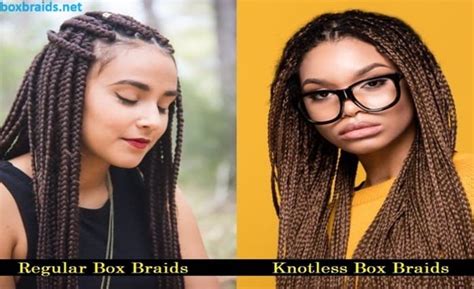Introduction

The hair care industry is a booming sector, with protective hairstyles becoming increasingly popular. Among the most favored options are box braids and knotless braids, both offering unique advantages and aesthetic appeal. However, choosing between these two styles can be a daunting task. To help you navigate this decision, we delve into a comprehensive comparison, exploring their differences, pros, cons, and suitability for various hair types and lifestyles.
1. Genesis and Technique
Box Braids
Box braids, also known as square braids, have been a staple in African culture for centuries. They are created by dividing the hair into even square sections, braiding from the base to the ends. The result is a series of distinctive, box-shaped braids.
Knotless Braids
Knotless braids, a more recent innovation, are similar to box braids but without the knots at the root. Instead, a feeding technique is employed, where hair is added to the base of the braid as you go rather than knotting it. This method reduces tension on the scalp, resulting in a more comfortable and less damaging hairstyle.
2. Advantages and Drawbacks
Box Braids
-
Pros:
- Timeless and versatile style
- Lasts longer than knotless braids (up to 8 weeks)
- Can be created with various sizes and lengths
- Relatively affordable
-
Cons:
- Can be heavy and cause scalp tension
- Time-consuming to install (can take 5-12 hours)
- Can lead to breakage if not properly maintained
Knotless Braids
-
Pros:
- Lightweight and comfortable to wear
- Reduced risk of scalp damage
- Faster to install (2-4 hours)
- More scalp exposure, allowing for better scalp care
-
Cons:
- Shorter lifespan (4-6 weeks)
- Can be more expensive than box braids
- May not be suitable for all hair types (e.g., very fine or slippery hair)
3. Suitability for Different Hair Types and Lifestyles
Box Braids
Box braids are generally suitable for all hair types, including thick, medium, and fine hair. They are an excellent choice for those who want a long-lasting, versatile style that can withstand active lifestyles.
Knotless Braids
Knotless braids are ideal for those with sensitive scalps, fragile hair, or who prefer a more comfortable and low-maintenance protective style. They are particularly well-suited for those who want to wear braids for shorter periods and prioritize scalp health.
4. Table Comparison: Box Braids vs Knotless Braids
| Feature | Box Braids | Knotless Braids |
|---|---|---|
| Technique | Box sections, knotted at the root | Feeding technique, no knots at the root |
| Longevity | Up to 8 weeks | 4-6 weeks |
| Cost | Relatively affordable | More expensive |
| Scalp Tension | High | Low |
| Breakage Risk | Higher (if not maintained properly) | Lower |
| Scalp Exposure | Limited | More exposure |
| Installation Time | 5-12 hours | 2-4 hours |
5. Styling Versatility and Maintenance
Both box braids and knotless braids offer a wide range of styling options, including buns, ponytails, top knots, and half-up styles. They can be adorned with beads, accessories, and hair wraps for added flair.
Maintenance for these styles is crucial. Regular washing and conditioning is necessary to keep the hair clean and healthy. Avoid using harsh products or excessive heat on the hair, which can lead to breakage or damage.
6. Common Mistakes to Avoid
- Over-tightening: Avoid braiding the hair too tightly, as this can cause scalp pain, breakage, and traction alopecia.
- Ignoring scalp care: Both box braids and knotless braids require regular scalp cleansing and moisturizing to prevent scalp irritation and promote healthy hair growth.
- Using incorrect products: Avoid using products containing alcohol or harsh chemicals on protective hairstyles, as these can dry out and damage the hair.
- Pulling or picking at the braids: This can weaken the braids and lead to premature unraveling.
- Ignoring removal: Remove protective hairstyles when they start to loosen or show signs of damage to prevent hair breakage and scalp issues.
Conclusion
Choosing between box braids and knotless braids ultimately depends on your hair type, lifestyle, and personal preferences. Both styles offer unique advantages and drawbacks, and the decision is best made in consultation with a professional hair stylist.
Remember to prioritize scalp health, maintain your braids properly, and seek professional help when removing them to ensure the longevity and beauty of your protective hairstyle.
